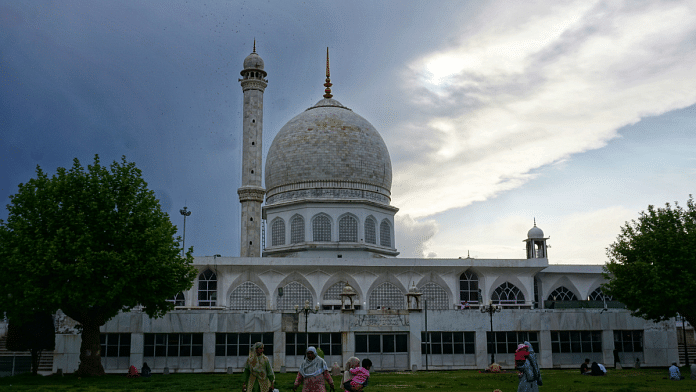New Delhi: Every year, thousands of Muslims visit the Hazratbal shrine on the banks of Dal Lake, one of the most revered religious sites in Kashmir that houses the holy relic of Prophet Mohammad — Moi-e-Muqaddas.
The shrine is now going to get a development boost, with Prime Minister Narendra Modi, who is in Srinagar, inaugurating the Hazratbal shrine development project as part of an ambitious Rs 1,400 crore plan to boost infrastructure and tourism in the Kashmir Valley.
Thursday’s visit to Kashmir was the first by PM Modi to the region after the abrogation of Article 370 in August 2019.
The Hazratbal shrine project will include the construction of a tourist facilitation centre as well as a Sufi interpretation centre, a multi-level car parking, and a boundary wall. The banks of Srinagar’s famous Dal Lake will be illuminated, and signages will be added.
The project was inaugurated virtually at Bakshi stadium in Srinagar as part of a slew of projects under the Swadesh Darshan and Pilgrimage Rejuvenation And Spiritual Augmentation Drive (PRASAD), which was launched with the aim of integrating “pilgrimage destinations in a prioritised, planned and sustainable manner to provide a complete religious tourism experience”.
“The path to building a developed Jammu and Kashmir will emerge from here. J&K is not just a region; it is the forehead of India. Viksit J&K is the priority of Viksit Bharat,” PM Modi said.
Also Read: 4 years on, Kashmir is changing. All because of Modi-picked Manoj Sinha’s healing touch
Significance in Kashmir
Dating back to the 17th century, the shrine was initially established by Inayat Begum, the daughter of Khwaja Nur-ud-Din Eshai, the custodian of the holy relic. The first building of the Hazratbal shrine was established by Mughal subedar Saqiq Khan.
The white-dombed Hazratbal shrine, surrounded by the mighty Chinars from all sides, was originally the site of Ishrat Mahal built by Khan. When Mughal emperor Shah Jahan arrived in Kashmir, he ordered the conversion of the palace into a place of worship.
“When Moi-e-Muqaddas arrived in Kashmir in 1699, it was kept in the Naqashbad Sahib for some time, before becoming a part of the Hazratbal,” reads the description on the official website of Hazratbal.
Each year, on the occasion of Eid-e-Milad, the Moi-e-Muqaddas is displayed when the faithful reach the shrine to catch a glimpse of the relic.
“Hazratbal shrine has been central to Kashmir’s landscape. All the influential people during the political movements have carried out rallies here. It was one of the main mobilising points during the freedom movement before Independence,” political analyst and retired Kashmir University professor Noor A. Baba told ThePrint.
Prof. Baba added that Hazratbal has been the most important pilgrimage centre for the Muslims in Kashmir. “Hazratbal is a tourist attraction. The project will help the shrine to become an excellent tourist spot since it’s already surrounded by Mughal Gardens.”
In December 1963, Kashmir witnessed an uproar after the sudden disappearance of the holy relic from the Hazratbal shrine. The then prime minister of India, Jawaharlal Nehru tasked Intelligence Bureau (IB) chief B.N. Mullik with the responsibility to recover it. The relic was in January 1964. Nehru is said to have complimented Mullik, saying: “You saved Kashmir for India.”
In 1968, popular Kashmir leader Sheikh Muhammad Abdullah reconstructed the Hazratbal shrine to its present shape under the auspices of the Auqaf Trust for relaunching his political movement.
The shrine was at the centre of Sheikh Abdullah’s politics, said Prof. Baba. “After him, Farooq Abdullah and even Omar Abdullah visited this place. Through them, it continued to remain the centre of politics in Kashmir.”
Over the years, the shrine has been the focal point of some of the biggest political as well as religious gatherings in Kashmir. During the political turmoil in the last few decades, some of the biggest protests have taken place in Hazratbal.
The foundation stone of a development project was laid in 2017, by then chief minister of Jammu and Kashmir, Mehbooba Mufti, during the PDP-BJP rule in the erstwhile state.
“For many Kashmiris who couldn’t afford to perform the Hajj pilgrimage, they found solace in visiting Hazratbal shrine,” Mohammad Ashraf Wani, a retired professor of history, told ThePrint.
(Edited by Tony Rai)
Also Read: Govt right to hold soldiers accountable for J&K civilian killings—focus on security system too



